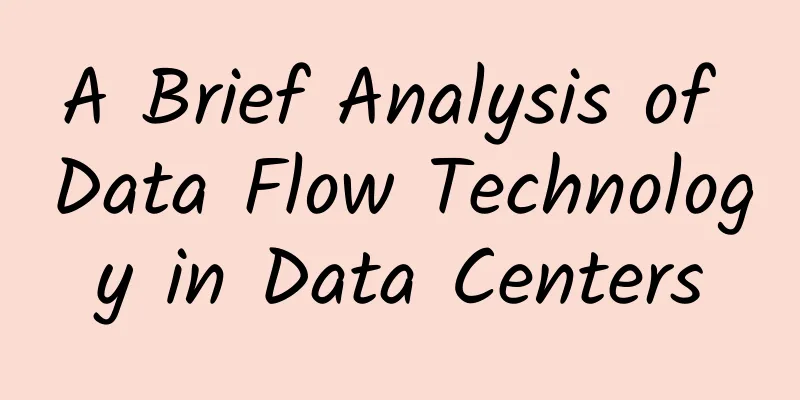A Brief Analysis of Data Flow Technology in Data Centers

|
What is the most valuable thing in a data center? Data. Data is the blood flowing in a data center, and it is also something that can generate benefits and bring value, so data is the most important to a data center. For example: systems that store personal information, bank accounts, network traffic fees, etc. If these data are lost, not only will it cause losses to customers, but it will also make billing impossible. In the past, the cost of using a data center could only be ignored, and the data center also reduced its income, resulting in a huge loss, so the data should be protected as much as possible. Some people may say that it would be safer to save more copies of the data. This is simple to say, but it is not so easy to do. The new data generated in the data center every day is massive. It is not only a simple copy, but also real-time and data availability must be considered. When the primary database fails, the business must be able to smoothly switch to the backup database, and the data must not be lost. This process is still very complicated. Traditional data copy backup cannot meet the real-time, rapid and uninterrupted requirements, so many technical experts have come up with many high-tech technologies to improve the data backup process and achieve the purpose of backing up data. The technology to achieve data backup is figuratively called data flow technology.
First, let's talk about CDP. CDP (Continues Data Protection) is continuous data protection. It does not need to stop the production database, the business, or change the existing configuration of the production database. It can achieve full replication and fine-grained capture effect in seconds. CDP is divided into Near CDP and True CDP. Near CDP performs data backup periodically according to time, commonly known as snapshots, and cannot actively judge data transactions. True CDP obtains the data transactions to be protected in real time and completely for the protected objects, and immediately records the data changes for future recovery. There are many disaster recovery and backup manufacturers in the industry who claim that their products are true CDP software products, but the actual situation is that most of the backup software claiming to be CDP can only be regarded as Near CDP products. Don't let the illusion blind your eyes. True CDP requires complex data processing technology to achieve real-time incremental replication of data. Next, let's talk about P2V. P2V (Physical to virtual) refers to migrating the operating system, application or data from the computer's physical hard disk to a virtual environment or disk partition to achieve backup and rapid reconstruction of the entire application environment. P2V transfers the existing physical server operating system together with all applications and document data stored on the hard disk to the built virtualization platform. The whole process is a bit like the one-click Ghost system on a PC. However, P2V is not Ghost. The migration process of P2V is to strip the operating system from the hardware driver and place it on the virtual layer. The virtual layer takes over the hardware driver and virtualizes the hardware resources into virtual resources that the operating system recognizes and can continue to allocate and use. When a fault occurs, the virtual machine is started to mount the image file to achieve disaster recovery. P2C also has two modes: scheduled full backup and real-time incremental backup. Scheduled full backup draws on VMWare's Converter technology and supports P2V for Windows and Linux operating systems. Real-time incremental backup uses real-time monitoring of disk read and write operations and synchronous conversion to virtual disk VMDK format. In addition to P2V, there are V2P, P2P, V2V, which convert between physical and virtual. P2V can virtualize and migrate old systems online through the network without interrupting business, but P2V also has disadvantages, that is, it is necessary to install an agent plug-in in the target machine, the network needs to be healthy, the target machine share can be accessed, there is administrator privileges, the target machine needs to be healthy, sometimes some services cannot be started, some policies are modified, resulting in the inability to successfully install the agent plug-in, and the P2V process must be implemented manually. Third, let's talk about mirrored active-active. Mirrored active-active is to deploy two sets of servers for business. Each set of servers is installed with dual-node mirror software. Each set of servers is divided into a partition with basically the same space for each business application (as a mirror disk), and the customer's business applications are installed in the corresponding mirror disk. Both sets of servers are used as master servers. They run their own applications independently during normal operation. The mirror software will automatically synchronize business data with each other. Once a failure occurs, the normal server will take over the business application of the failed server, and run its own business application and the business application of the other machine at the same time, ensuring that the core business of the data center runs 7*24 hours uninterruptedly. The two sets of servers are placed in different data centers, so cross-data backup is safer. The data on the normal server is backed up in real time through mirroring. The data is doubled, which increases the security of the data, and can automatically recover and switch automatically in case of failure. The switching speed is fast and unattended. Mirrored active-active does not require the deployment of expensive disk arrays, saving data storage costs. ***Let's talk about cluster disaster recovery. A cluster is a group of service entities that work together to provide a service platform with greater scalability and availability than a single service entity. From a business perspective, a cluster is a service entity, but in fact a cluster is composed of a group of service entities. In a data center, a service entity is a group of server devices of varying numbers. Clusters can effectively improve system availability. If a server or application crashes, other servers in the cluster system will continue to work while taking over the tasks of the crashed server, thus minimizing the downtime of user servers and applications. Cluster disaster recovery is to build storage systems in both the primary and backup data centers. The cluster servers in the primary data center gain control of the storage system, and all application data will be copied to the backup data center in real time. When the primary data center fails, the primary server of the primary data center fails, and the backup server automatically takes over. If a disaster occurs in the primary data center, the servers in the cluster of the backup data center will mount the storage and immediately provide services to the outside world. The entire process is completed automatically, the business transition is smooth, and data will not be lost. Virtualization technology, database backup technology, etc. are all data flow technologies. Only with these technologies can the operating data of the data center be protected. The international standard SHARE78 defines multiple levels of disaster recovery. Disaster recovery solutions can be formulated based on multiple aspects, and the data losslessness directly determines the backup level of the data center. |
<<: Software Defined Data Center (SDDC) Architecture for Beginners
Recommend
Empowering dream makers in the intelligent era: the breakthrough and establishment of Huawei’s terminal distributed technology
[51CTO.com original article] Many people compare ...
Feiyuxing Wireless helps Wuhan Tilisaer complete panoramic coverage of office buildings
When it comes to staying beautiful, this is proba...
The ultimate secret to speeding up WiFi is here!
[[434247]] Reasonable configuration of channel wi...
After the number portability function is enabled, the largest number of users transfer out of China Mobile
Number portability was officially launched nation...
The number of 5G users of South Korea's three major operators has increased, but the network quality has received a lot of complaints
According to data released by market tracker FnGu...
[11.11]80VPS: 50% off all VPS, special VPS annual payment starting from 199 yuan, multiple data centers in Hong Kong/US/Japan/Korea, etc.
80VPS also launched a promotion during the Double...
How to protect remote workers from cyber attacks?
[[400945]] During the coronavirus outbreak around...
[Black Friday] ITLDC: Unlimited traffic VPS annual payment 40% off €22.98/year, 15 data centers in the United States/Singapore/Netherlands/Ukraine, etc.
ITLDC's Black Friday promotion targets regula...
80VPS: US 8C cluster server monthly payment starts from 800 yuan, Hong Kong 8C cluster server monthly payment starts from 1000 yuan
Recently, some readers asked about cluster server...
PQHosting Summer Promotion 15% off, 33 data centers 1Gbps unlimited traffic VPS monthly payment from 4.77 euros
PQ HOSTING released an email about summer promoti...
Interpreting the four major reasons why my country is comprehensively promoting the implementation of IPv6!
In November 2017, the General Office of the CPC C...
In the first half of the year, Internet companies above designated size achieved business revenue of 695.1 billion yuan, a year-on-year increase of 25.6%.
Recently, the Ministry of Industry and Informatio...
How to store IP addresses in MySQL efficiently?
A few days ago, a friend of mine went to an inter...
Driving industrial transformation in the intelligent era, Huawei Intelligent Computing 2019 is ready to go!
[51CTO.com original article] The first time the r...
HostYun Los Angeles, USA, CN2 GIA line AMD series VPS monthly payment starts from 16 yuan, native IP
HostYun recently launched a VPS with AMD 5950X+Sa...









